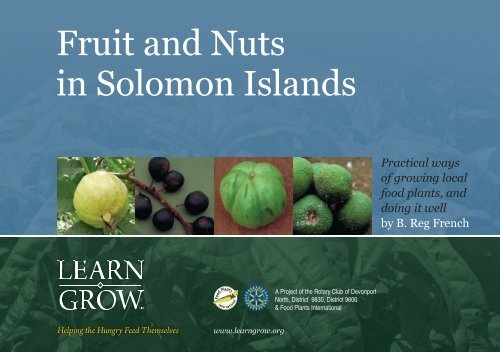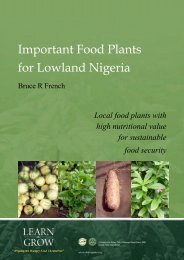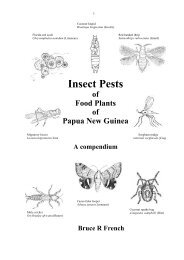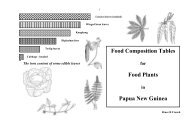Solomon Islands Fruit and Nuts - Learn Grow
Solomon Islands Fruit and Nuts - Learn Grow
Solomon Islands Fruit and Nuts - Learn Grow
Create successful ePaper yourself
Turn your PDF publications into a flip-book with our unique Google optimized e-Paper software.
<strong>Fruit</strong> <strong>and</strong> <strong>Nuts</strong> in <strong>Solomon</strong> <strong>Isl<strong>and</strong>s</strong><br />
This is one of a series of publications produced for the<br />
<strong>Learn</strong><strong>Grow</strong> <strong>Solomon</strong> <strong>Isl<strong>and</strong>s</strong> project.<br />
Other publications in the series are:<br />
Food Plants of <strong>Solomon</strong> <strong>Isl<strong>and</strong>s</strong> – A Compendium (published July 2010). A large reference text<br />
with comprehensive scientific <strong>and</strong> technical information on all food plants of <strong>Solomon</strong> <strong>Isl<strong>and</strong>s</strong>.<br />
Food Crops of <strong>Solomon</strong> <strong>Isl<strong>and</strong>s</strong> – A Brief Introduction to the Crops (published March 2011). A<br />
book on the growing practices <strong>and</strong> food value of crops of potential in <strong>Solomon</strong> <strong>Isl<strong>and</strong>s</strong>.<br />
Two other field guides in this series are:<br />
Good Gardening <strong>and</strong> <strong>Grow</strong>ing Root Crops in <strong>Solomon</strong> <strong>Isl<strong>and</strong>s</strong> (published July 2010).<br />
Leafy Greens <strong>and</strong> Vegetables in <strong>Solomon</strong> <strong>Isl<strong>and</strong>s</strong> (published July 2010)<br />
All publications will be made available as pdf books on the <strong>Learn</strong>♦<strong>Grow</strong> website (www.learngrow.org)<br />
<strong>and</strong> the Food Plants International website (www.foodplantsinternational.com)<br />
© 2011 Food Plants International Inc.<br />
ISBN 978-0-9808182-5-3<br />
<strong>Learn</strong>♦<strong>Grow</strong><br />
A project of the Rotary Club of Devonport North, District 9830,<br />
District 9600 & Food Plants International
<strong>Fruit</strong> <strong>and</strong> <strong>Nuts</strong> in <strong>Solomon</strong> <strong>Isl<strong>and</strong>s</strong><br />
Practical ways of growing local food plants,<br />
<strong>and</strong> doing it well<br />
Contents<br />
<strong>Fruit</strong> 1 - 38<br />
<strong>Nuts</strong> 39 - 61<br />
Other publications in this series<br />
Good Gardening <strong>and</strong> <strong>Grow</strong>ing Root Crops<br />
in <strong>Solomon</strong> <strong>Isl<strong>and</strong>s</strong><br />
Leafy Greens <strong>and</strong> Vegetables in <strong>Solomon</strong> <strong>Isl<strong>and</strong>s</strong>
Pineapple<br />
Carambola<br />
<strong>Solomon</strong> <strong>Isl<strong>and</strong>s</strong><br />
l<strong>and</strong> of fabulous fruit<br />
1<br />
Watermelon<br />
Pawpaw
<strong>Fruit</strong> taste good <strong>and</strong> keep us healthy<br />
New Guinea walnut<br />
Rakwan<br />
Everybody should eat<br />
some fruit every day<br />
Good gardeners<br />
<strong>and</strong> farmers plant<br />
several kinds of<br />
fruit trees<br />
Pacific lychee<br />
<strong>Fruit</strong> provide minerals, vitamins <strong>and</strong> other important<br />
nutrients that everybody needs to stay healthy <strong>and</strong> well<br />
Golden apple Malay apple<br />
2<br />
Kona
Pomelo<br />
<strong>Fruit</strong> for hot humid climates<br />
Pawpaw<br />
Pineapple Mango<br />
<strong>Fruit</strong> to be enjoyed by all<br />
Some grow quickly<br />
Some need to be planted<br />
for the future<br />
Many are seasonal<br />
3<br />
Watermelon<br />
Soursop
Watery rose apple<br />
<strong>Fruit</strong> - for flavour <strong>and</strong> vitamins<br />
Natu/Kona<br />
Guava Breadfruit<br />
4
Enjoy fruit to enjoy a good life<br />
<strong>Fruit</strong> add flavour to life<br />
<strong>Fruit</strong> are often rich in vitamins<br />
<strong>Fruit</strong> make good quick snacks<br />
<strong>Fruit</strong> are fun<br />
We are meant to enjoy the exciting<br />
flavours <strong>and</strong> textures of an amazing<br />
variety of tropical fruit<br />
5
Bananas - a good snack food<br />
Yellow-fleshed bananas are normally rich in<br />
carotenoids that help good eyesight.<br />
Ask someone who<br />
knows bananas<br />
well to find out<br />
which ones are<br />
sweet <strong>and</strong> which<br />
are for cooking.<br />
Musa spp<br />
Many <strong>Solomon</strong> <strong>Isl<strong>and</strong>s</strong><br />
bananas ripen into<br />
sweet snack foods.<br />
6<br />
Bananas are rich<br />
in potassium<br />
which helps<br />
maintain normal<br />
blood pressure
Pineapple - a popular snack<br />
Ananas comosus<br />
7<br />
Planting the lowest<br />
suckers gives fruit<br />
more quickly.
Bukubuk - an undiscovered specialty<br />
Burckella obovata<br />
Noneu<br />
8<br />
Kona<br />
Nyiu Nyinou<br />
Natu<br />
Gona<br />
Nasu<br />
Hovaka<br />
Chovuku<br />
Gono
Durian - introduced from Indonesia<br />
Unripe fruit can<br />
be cooked as a<br />
vegetable. Seeds<br />
can be cooked<br />
<strong>and</strong> eaten.<br />
9<br />
Trees can be<br />
grown from fresh<br />
seed <strong>and</strong> take 10<br />
years to grow.<br />
Durio zibethinus
Jackfruit - becoming better known<br />
Unripe fruit can<br />
be cooked <strong>and</strong><br />
eaten as a<br />
vegetable.<br />
Young leaves<br />
<strong>and</strong> flowers can<br />
be mixed into<br />
stews.<br />
The flesh of ripe<br />
fruit can be<br />
eaten raw.<br />
Seeds can be<br />
eaten roasted or<br />
boiled.<br />
10<br />
Artocarpus heterophyllus
Soursop - an easy to grow coastal fruit<br />
The flesh of the<br />
fruit can be<br />
sieved to<br />
remove seeds<br />
then added to<br />
sweet dishes.<br />
<strong>Fruit</strong> in this<br />
family help<br />
reduce cancer.<br />
11<br />
Annona muricata
Sweetsop - suits dry areas<br />
Trees can survive drought <strong>and</strong> grow<br />
in fairly poor soils.<br />
The fruit can be eaten raw or used<br />
for drinks.<br />
12<br />
Annona<br />
squamosa
Bullock’s heart - on coastal isl<strong>and</strong>s<br />
Annona reticulata<br />
<strong>Fruit</strong> can be eaten fresh<br />
or used for drinks.<br />
13<br />
It needs a humid<br />
climate <strong>and</strong> can’t<br />
tolerate<br />
waterlogged soils.
Guava - vitamin C for children<br />
Psidium guajava<br />
<strong>Fruit</strong> are<br />
rich in<br />
vitamin C<br />
Trees grow easily <strong>and</strong> should be near<br />
houses so children can enjoy the fruit<br />
14
Citrus gr<strong>and</strong>is<br />
Pomelo - the big tropical citrus<br />
15
West Indian limes<br />
suit tropical places<br />
Lemons can be<br />
used for drinks<br />
Citrus fruit<br />
Most citrus trees in<br />
the hot, humid<br />
tropics simply breed<br />
pests <strong>and</strong> diseases<br />
M<strong>and</strong>arins peel easily<br />
There are much better<br />
plants than citrus for<br />
producing vitamin C<br />
16<br />
In the tropics, “oranges” often<br />
stay green, even when ripe<br />
Grapefruit are not suited<br />
to hot, damp places
Tava<br />
Awa<br />
Tao<br />
Taoa<br />
Mede<br />
Pometia pinnata<br />
Pacific lychee<br />
A traditional <strong>Solomon</strong> Isl<strong>and</strong><br />
fruit, beautiful in season<br />
17<br />
Piraka taba<br />
Nodae<br />
Ako/Dawa<br />
Nyia tave<br />
Gema
<strong>Fruit</strong> can be eaten<br />
raw or cooked<br />
Avocado - suits cooler areas<br />
A very<br />
nutritious<br />
fruit<br />
Persea americana<br />
18
Edible fig - edible leaves <strong>and</strong> fruit<br />
Several kinds of fig<br />
fruit are crunchy <strong>and</strong><br />
edible<br />
Ficus copiosa <strong>and</strong><br />
Ficus wassa<br />
19
New Guinea walnut- small with 5 flecks<br />
around the fruit<br />
<strong>Fruit</strong> can be eaten<br />
raw or cooked<br />
Leaves <strong>and</strong> flowers can<br />
be cooked <strong>and</strong> eaten<br />
Dracontomelon dao<br />
20
Indian mulberry - a food <strong>and</strong> medicine<br />
Morinda citrifolia<br />
Young<br />
leaves can<br />
be cooked<br />
<strong>and</strong> eaten.<br />
21<br />
<strong>Fruit</strong> can be eaten<br />
raw or cooked. They<br />
can be eaten with<br />
salt, <strong>and</strong> young fruit<br />
are used in curries.<br />
It is becoming<br />
known as a health<br />
food or medicine.
Mulberry fruit - a tasty bonus to mulberry leaves<br />
Morus alba<br />
22<br />
<strong>Fruit</strong> can be eaten raw or cooked.<br />
The young leaves can be cooked<br />
<strong>and</strong> eaten.
Carambola – the five-corner fruit with lemon<br />
sweetness for flavouring foods<br />
Sweet fruit can be eaten<br />
raw or as a lemon<br />
flavour in cooking.<br />
The acid leaves <strong>and</strong><br />
flowers can also be<br />
used.<br />
Averrhoa carambola<br />
23
Bilimbi - a very sour fruit for souring dishes<br />
A very acid fruit used for<br />
souring or flavouring .<br />
The flowers can be used<br />
for making conserves.<br />
Averrhoa bilimbi<br />
24
Chrysophyllum<br />
cainito<br />
Velvet apple <strong>and</strong> Star apple -<br />
introduced into some regions<br />
Diospyros<br />
philippensis<br />
The hairs <strong>and</strong> skin are removed <strong>and</strong> the flesh of<br />
the fruit eaten.<br />
These are part of a large family of tropical fruit.<br />
25
Japanese persimmon - introduced<br />
but not common<br />
Diospyros kaki<br />
<strong>Fruit</strong> can be cooked, or<br />
eaten raw when very ripe.<br />
26
Mango - a lowl<strong>and</strong>s favourite,<br />
especially in seasonally dry areas<br />
A popular<br />
seasonal<br />
fruit.<br />
Some seedlings breed<br />
true to type giving new<br />
plants like the parent<br />
one.<br />
27<br />
Mangifera indica
Watermelon - cool <strong>and</strong> refreshing on<br />
hot s<strong>and</strong>y soils<br />
Citrullus lanatus<br />
The seeds are<br />
nutritious<br />
when dried,<br />
salted <strong>and</strong><br />
roasted . They<br />
are rich in zinc<br />
<strong>and</strong> protein.<br />
28
Golden apple - with 3 lines <strong>and</strong> a spiky seed<br />
Nyia tevi<br />
Tevi<br />
Noli<br />
Opiti<br />
Auri<br />
Gnoe<br />
<strong>Fruit</strong> are<br />
peeled<br />
<strong>and</strong> eaten.<br />
Aioo kwai<br />
Ainakori<br />
Piraka<br />
Ngongoe<br />
Bi<br />
29<br />
Uli<br />
Aio<br />
Spondias cytherea<br />
Young leaves can be<br />
eaten raw or cooked.
Lime berry - a fruit for jams or jellies,<br />
eaten raw or cooked<br />
30<br />
Triphasia trifolia<br />
A spiny shrub that can be<br />
grown as a hedge. The fruit<br />
can be pickled.
Tembu - a unique isl<strong>and</strong> fruit<br />
<strong>Fruit</strong> can be eaten raw or<br />
cooked.<br />
Tembu<br />
Nodombu<br />
Putsahlueo<br />
Nyia nwadabu<br />
31<br />
Corynocarpus<br />
cribbianus<br />
Ibo bala<br />
Tebu<br />
Ibo
Naranjilla - an Andes fruit for the highl<strong>and</strong>s<br />
The fruit can be eaten fresh<br />
<strong>and</strong> the seeds are edible.<br />
A small shrub with<br />
large soft leaves<br />
<strong>and</strong> round hairy<br />
fruit.<br />
32<br />
Solanum quitoense
This tall<br />
shrub does<br />
better in<br />
cooler areas<br />
in the hills.<br />
Tamarillo – the tree tomato<br />
33<br />
Cyphom<strong>and</strong>ra betacea<br />
The fruit can be eaten<br />
raw or cooked.
Rosella - good for a very easy jam<br />
The flowers can<br />
be used to<br />
flavour drinks<br />
<strong>and</strong> the young<br />
leaves can be<br />
cooked <strong>and</strong><br />
eaten.<br />
Hibiscus<br />
sabdariffa<br />
The fleshy bracts around the flower<br />
are picked <strong>and</strong> cooked <strong>and</strong> eaten, or<br />
used for jam or drinks.<br />
34
Pawpaw - self-sown in the lowl<strong>and</strong>s<br />
Pawpaw fruit can be<br />
cooked as a vegetable<br />
while green, or eaten ripe<br />
as a fruit.<br />
Carica papaya<br />
35<br />
Long fruited kinds do not need<br />
male trees for pollination.<br />
Male flowers can be cooked <strong>and</strong><br />
eaten.
Karukae<br />
Kabirai<br />
Gafiga Hipala<br />
Ghabiga<br />
Hahika<br />
Malay apple<br />
Syzygium malaccense<br />
Kaviha<br />
Apuchu<br />
Afio<br />
36<br />
Kapika<br />
Gahiga<br />
Sa’u<br />
The fruit can be eaten<br />
raw or cooked, or used<br />
for jam or pickles.
Syzygium aqueum<br />
Watery rose apple<br />
The small<br />
crunchy fruit<br />
are eaten raw.<br />
Plants can be<br />
grown from<br />
cuttings or by<br />
air layering.<br />
37
The fruit can be<br />
used for jam,<br />
sauces <strong>and</strong><br />
pickles.<br />
Rukam - an Asian fruit<br />
The fruit are often<br />
rubbed between the<br />
h<strong>and</strong>s to make them<br />
sweeter to eat.<br />
Flacourtia rukam<br />
38<br />
The young leaves can<br />
be cooked <strong>and</strong> eaten.
<strong>Solomon</strong> <strong>Isl<strong>and</strong>s</strong><br />
l<strong>and</strong> of amazing nut foods<br />
39
Kat nat<br />
<strong>Nuts</strong> - nutritious, storable <strong>and</strong> tasty<br />
Breadfruit<br />
Alita fasia Ailali<br />
40
Every family needs some nut trees<br />
Coastal almond Finschia nuts<br />
Ailali nuts<br />
Plant trees now for your<br />
children <strong>and</strong> gr<strong>and</strong>children<br />
to enjoy in the future.<br />
Kat nuts<br />
Breadfruit Water chestnut<br />
41<br />
They are better food<br />
than snack foods<br />
from stores.
For protein, minerals <strong>and</strong> vitamins,<br />
try nuts!<br />
A seasonal variation in the diet<br />
Often a storable reserve food<br />
Often loved by children<br />
Cheaper <strong>and</strong> better than bought snack foods<br />
Seasonal gifts to<br />
enhance diets<br />
42
Breadfruit - a child’s delight<br />
The large seeds are<br />
roasted <strong>and</strong> eaten.<br />
The fruit <strong>and</strong> young<br />
leaves are also<br />
cooked <strong>and</strong> eaten.<br />
43<br />
Artocarpus altilis
The seeds can be<br />
eaten raw or cooked.<br />
The ripe fruit is very<br />
dry to eat.<br />
Rakwan - a breadfruit relative<br />
Boboe Rakwana<br />
Tageva Boe Nhego Rakwan<br />
44<br />
Parartocarpus venenosus
Alita fasia (Okari) - a delight in the lowl<strong>and</strong>s<br />
Ghaghimanga<br />
Nyiga<br />
The kernel can<br />
be eaten raw<br />
or roasted.<br />
Talise/Manavasa<br />
Tatalise/Hogolo<br />
Talia lavata<br />
45<br />
Terminalia kaernbachii
Coastal almond - zinc supplement,<br />
especially good for children<br />
Terminalia catappa<br />
<strong>Nuts</strong> are rich in<br />
zinc <strong>and</strong> planting<br />
of extra trees is<br />
encouraged.<br />
Talia suka<br />
Tatalise<br />
Tangie<br />
Talie<br />
46<br />
Alita<br />
Arite<br />
Arete/ Oko<br />
Talima<br />
Naklise<br />
Lenga
Angari<br />
Canarium harveyii<br />
Ngali nut - a nice nut<br />
Nyia Nyinge<br />
Ngali Ngari<br />
47<br />
Nolepo<br />
Okete<br />
Ngoeta<br />
Voi’a
Suga/Lenge (Tu-lip) - a great snack food <strong>and</strong> nut<br />
Dae Sa naroka Suagafa Poke<br />
Gnetum gnemon<br />
Kekoso Houka<br />
Lenge<br />
Tasty <strong>and</strong> nutritious<br />
leaves, flowers <strong>and</strong> nuts<br />
Dae fasia<br />
48
Ailali (Polynesian chestnut) - a coastal <strong>and</strong> Pacific<br />
Isl<strong>and</strong> favourite<br />
Dulafa Mwaqe<br />
Mabe<br />
The nuts are boiled or<br />
roasted <strong>and</strong> eaten.<br />
Paravua<br />
Inocarpus fagifer<br />
Gnuilaba Paravu Ailali<br />
Nokomo<br />
49<br />
Julapa<br />
Nyia Oki<br />
Ifi<br />
Isi<br />
Ivi
Kat nuts - a highly popular coastal nut<br />
Hara<br />
Barringtonia species<br />
Vele<br />
Kinu<br />
Falang anoa<br />
Tamalivi<br />
Aikenu<br />
Tuhala<br />
Kenu<br />
Fara<br />
50<br />
Fala<br />
Oneve
Finschia nuts - like macadamias<br />
Pakopako Huhula<br />
Amiki Igula Mimo<br />
Ngo’ongo’o<br />
Kamwa kamwa<br />
Ghaapoli mongi<br />
Amusi kilikacha<br />
Nonali mato<br />
Tivanono<br />
Quruqasa<br />
Gaegale<br />
51<br />
Finschia chloroxantha
Nypa fruticans<br />
The stalk can be cut<br />
for sap.<br />
Nypa nuts - in the mangroves<br />
52<br />
The young kernels<br />
inside the hard shell<br />
can be eaten.
P<strong>and</strong>anus - occasionally used nuts<br />
P<strong>and</strong>anus tectorius<br />
The fleshy base of the fruit can be<br />
chewed <strong>and</strong> the nut can be eaten.<br />
Nyiu nailo<br />
Lou lou Nonivo Kaufadai<br />
53<br />
Faudai/Tone<br />
Kaufa tolo<br />
Poroporo<br />
Fa’u da’i<br />
Fao<br />
Vahara<br />
Tobi<br />
Vaha<br />
P<strong>and</strong>anus compressus
Water chestnut - arriving from Panama<br />
through the Pacific<br />
Seeds can<br />
be eaten<br />
raw but are<br />
best cooked<br />
to get rid of<br />
seed toxins.<br />
Plants can be grown from fresh seeds<br />
or cuttings.<br />
Leaves <strong>and</strong><br />
flowers can<br />
be cooked<br />
<strong>and</strong> eaten.<br />
54<br />
Pachira aquatica
Coconut - a daily delight for those<br />
who can hear the sea<br />
The liquid can be drunk, the flesh eaten,<br />
<strong>and</strong> the germinating "apple" eaten.<br />
Cocos nucifera<br />
55
Arachis hypogea<br />
Peanut - a bean eaten as a nut<br />
Seeds are<br />
nutritious <strong>and</strong><br />
can be eaten<br />
raw or cooked.<br />
Peanuts can<br />
improve the<br />
soil <strong>and</strong><br />
provide food.<br />
56
Salak - a prickly palm fruit/nut from Indonesia<br />
Male <strong>and</strong> female plants are both<br />
needed to get fruit, which can be<br />
eaten when ripe.<br />
Salak grows<br />
well in damp<br />
ground, such as<br />
in drains.<br />
Salacca zalacca<br />
57
Betel nut - the world’s most popular masticatory<br />
but probably not good for the health or diet!<br />
The palm heart<br />
can be eaten but<br />
this kills the<br />
palm.<br />
Kasu<br />
Areca catechu<br />
58<br />
Bua<br />
Angiro/Malua<br />
Nyia nwotapi<br />
Nokalua<br />
Ota<br />
Pua<br />
Pijaka Gaisa
C<strong>and</strong>le nut - a nut that burns, <strong>and</strong> can be eaten<br />
after careful cooking<br />
This hard oily nut must be<br />
cooked to remove poisons. It<br />
can be used to flavour <strong>and</strong><br />
thicken dishes.<br />
Aleurites moluccana<br />
59
Pangi or Sis nuts - highly poisonous until<br />
properly processed<br />
All parts of this<br />
plant are very<br />
poisonous. The<br />
nuts are eaten after<br />
a long process of<br />
cooking, washing<br />
<strong>and</strong> fermenting.<br />
60<br />
Pangium edule
<strong>Nuts</strong> with commercial potential<br />
Okari – Alita fasia Kat nat<br />
Polynesian chestnut<br />
There is a ready market for these nuts - grow them for sale<br />
Coastal almond Tu-lip<br />
Ngali<br />
61
Scientific name index<br />
The scientific name is the same in all languages<br />
English name Scientific name Page English name Scientific name Page<br />
Ailali Inocarpus fagifer 49 Carambola Averrhoa carambola 23<br />
Alita fasia Terminalia kaernbachii 45 Citrus fruit Citrus spp 16<br />
Avocado Persea americana 18 Coastal almond Terminalia catappa 46<br />
Banana Musa spp. 6 Coconut Cocos nucifera 55<br />
Betel nut Areca catechu 58 Durian Durio zibethinus 9<br />
Bilimbi Averrhoa bilimbi 24 Figs Ficus spp. 19<br />
Breadfruit Artocarpus altilis 43 Finschia nuts Finschia chloroxantha 51<br />
Bukubuk Burckella obovata 8 Golden apple Spondias cytherea 29<br />
Bullock’s heart Annona reticulata 13 Guava Psidium guajava 14<br />
C<strong>and</strong>le nut Aleurites moluccana 59 Indian mulberry Morinda citrifolia 21<br />
62
Scientific name index<br />
The scientific name is the same in all languages<br />
English name Scientific name Page English name Scientific name Page<br />
Jackfruit Artocarpus heterophyllus 10 Ngali nut Canarium harveyii 47<br />
Japanese<br />
persimmon<br />
Diospyros kaki 26 Nypa nuts Nypa fruticans 52<br />
Kat nut Barringtonia spp. 50 Pacific lychee Pometia pinnata 17<br />
Lime berry Triphasia trifolia 30 P<strong>and</strong>anus P<strong>and</strong>anus spp. 53<br />
Malay apple Syzygium malaccense 36 Pangi Pangium edule 60<br />
Mango Mangifera indica 27 Pawpaw Carica papaya 35<br />
Mulberry Morus alba 22 Peanut Arachis hypogea 56<br />
Naranjilla Solanum quitoense 32 Pineapple Ananas comosus 7<br />
New Guinea<br />
walnut<br />
Dracontomelon dao 20 Pomelo Citrus gr<strong>and</strong>is 15<br />
63
Scientific name index<br />
The scientific name is the same in all languages<br />
English name Scientific name Page English name Scientific name Page<br />
Rakwan Parartocarpus venenosus 44 Sweetsop Annona squamosa 12<br />
Rosella Hibiscus sabdariffa 34 Tamarillo Cyphom<strong>and</strong>ra betacea 33<br />
Rukam Flacourtia rukam 38 Tembu<br />
64<br />
Corynocarpus<br />
cribbianus<br />
Salak Salacca zalacca 57 Tu-lip Gnetum gnemon 48<br />
Sis Pangium edule 60 Velvet apple Diospyrus philippensis 25<br />
Soursop Annona muricata 11 Water chestnut Pachira aquatica 54<br />
Star apple Chrysophyllum cainito 25 Watermelon Citrullus lanatus 28<br />
Suga/Lenge Gnetum gnemon 48<br />
Watery rose<br />
apple<br />
31<br />
Syzygium aqueum 37
Notes<br />
65
Notes<br />
66
Notes<br />
67
Acknowledgements<br />
This booklet is one publication in a series developed by the Rotary District 9830 <strong>Learn</strong><strong>Grow</strong> project <strong>and</strong><br />
the printing of it was made possible thanks to the generous support of the Crawford Fund. The production of<br />
this booklet has been made possible through the support of the Food Plants International <strong>and</strong> <strong>Learn</strong><strong>Grow</strong><br />
project teams, the Rotary Clubs of District 9830, particularly the Rotary Club of Devonport North who<br />
founded the project, <strong>and</strong> the Rotary Clubs of Launceston West <strong>and</strong> Hobart. The development <strong>and</strong><br />
implementation of the program in <strong>Solomon</strong> <strong>Isl<strong>and</strong>s</strong> would not have been possible without the support of<br />
Rotary District 9600 <strong>and</strong> the Rotary Clubs of Honiara <strong>and</strong> Gizo, <strong>and</strong> this is gratefully acknowledged. The<br />
ongoing support from Rotary District 7610, the Rotary Club of Burke, Kieran Bradley (Workhorse Design<br />
Group) <strong>and</strong> Print Domain is also gratefully acknowledged.<br />
Nothing would have been possible without the commitment <strong>and</strong> support of the volunteers, some affiliated<br />
with Rotary Clubs, <strong>and</strong> some not, who have shared the vision, <strong>and</strong> unselfishly given their time <strong>and</strong> energy<br />
over several years to support this project. Particular thanks to Rotarian Buz Green for his leadership <strong>and</strong><br />
contribution to the project <strong>and</strong> to John McPhee for his dedicated efforts in compiling, formatting <strong>and</strong> final<br />
editing of the series of publications.<br />
For more information, visit the website www.learngrow.org.<br />
68





